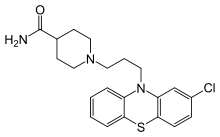Pipamazine
Pipamazine (INN; trade names Mornidine, Mometine, Nausidol) is a drug of the phenothiazine class formerly used as an antiemetic. It is chemically related to chlorpromazine, but has negligible antipsychotic activity and produces few extrapyramidal side effects.[1]
 | |
| Clinical data | |
|---|---|
| Pregnancy category |
|
| Routes of administration | Oral, intramuscular injection |
| ATC code |
|
| Legal status | |
| Legal status |
|
| Identifiers | |
IUPAC name
| |
| CAS Number | |
| PubChem CID | |
| ChemSpider | |
| UNII | |
| KEGG | |
| ChEMBL | |
| CompTox Dashboard (EPA) | |
| ECHA InfoCard | 100.001.375 |
| Chemical and physical data | |
| Formula | C21H24ClN3OS |
| Molar mass | 401.95 g/mol g·mol−1 |
InChI
| |
| | |
Pipamazine was introduced to the U.S. market in 1959 by G. D. Searle & Company. It was advertised for morning sickness[2] and postoperative nausea and vomiting, and was claimed to reduce the need for postoperative analgesia.[3] It was eventually withdrawn from the U.S. market in 1969, after reports of hepatotoxicity (liver injury).[4][5]
There is very little published information on pipamazine; it is mostly absent from modern-day sources, apart from a few passing mentions in the pharmacological literature.[1]
Adverse effects
Mornidine advertisements for postoperative recovery claimed "unusually low side effects".[3] However, contemporary comparative trials found that hypotension (low blood pressure) was a substantial concern when the drug was given at normal dosages for this indication; blood pressure reductions of up to 70 mmHg were reported.[6] Reductions in dosage mitigated hypotension while maintaining antiemetic efficacy.
In his book The Creation of Psychopharmacology, Irish psychiatrist David Healy states that the failure of pipamazine to perform as a neuroleptic and its negative side effect profile helped Searle lose interest in the antipsychotic sector, and contributed to the company's refusal to market haloperidol in the United States.[7]
References
- Frota LH (2003). Cinqüenta anos de medicamentos antipsicóticos em psiquiatria (PDF) (in Portuguese) (1st ed.). Rio de Janeiro: UFRJ. p. 486. ISBN 85-903827-1-0.
- [No authors listed] (July 1959). "Now she can cook breakfast again..." (PDF). Canadian Medical Association Journal. 81 (1): 59. PMC 1830735. Advertisement.
- [No authors listed] (April 1960). "Lessened postoperative vomiting with MORNIDINE" (PDF). Annals of Surgery. 151 (4). PMC 1613578. Advertisement.
- 34 FR 12051. July 17, 1969.
- Wysowski DK, Swartz L (June 2005). "Adverse drug event surveillance and drug withdrawals in the United States, 1969–2002: the importance of reporting suspected reactions". Archives of Internal Medicine. 165 (12): 1363–9. doi:10.1001/archinte.165.12.1363. PMID 15983284.
- Blatchford E (March 1961). "Studies of anti-emetic drugs: A comparative study of cyclizine (Marzine), pipamazine (Mornidine), trimethobenzamide (Tigan), and hyoscine". Canadian Journal of Anesthesia. 8 (2): 159–65. doi:10.1007/BF03021345.
- Healy D (2002). "Explorations in a new world". The creation of psychopharmacology. Cambridge: Harvard University Press. pp. 123–4. ISBN 0-674-01599-1.